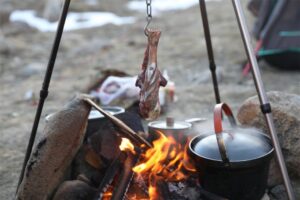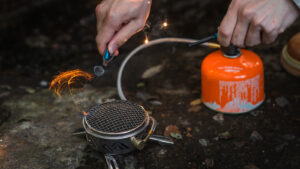 Tired of dreading camp meal prep because of a disorganized kitchen setup?
Tired of dreading camp meal prep because of a disorganized kitchen setup?
Are you sick of being afraid to prepare meals for camp because your kitchen is messy? Wrangling pots, lids, spices, and utensils can quickly turn pre-trip excitement into frustration.
But it doesn’t have to be that way!
This post dives deep into clever camp kitchen storage solutions that will have you packing up and hitting the road with ease. Learn how to maximize space, keep everything organized, and ensure those camp meals are a breeze —- because after all, shouldn’t camp cooking be about enjoying the outdoors, not wrestling with your gear?
How do I organize my camping kitchen?
● Use bins and containers
This is a great way to keep your food, dishes, and cooking utensils organized. Look for bins that are different sizes so you can find the perfect one for each item. You can also use clear bins so you can easily see what’s inside.
● Pack your cooler strategically
When packing your cooler, put the items you’ll need at the bottom. This way, you won’t have to dig through everything to get to the milk or juice. Freeze some water bottles ahead of time to help keep your food cold.
● Use a camp kitchen table with storage
A camp kitchen table with storage is a great way to keep your food and cooking supplies off the ground and out of the reach of animals. Look for a table with shelves or compartments that can hold your dishes, pots, and pans.
● Hang a camp organizer
This is a great way to store your utensils, dish towels, and other small items. You can hang it from a tree branch or the awning of your tent.
● Use stuff sacks for bulky items.
Stuff sacks are a great way to store bulky items like sleeping bags and camp chairs. They come in a variety of sizes, so you can find one that’s the perfect size for each item.
● Pack a dishwashing bin.
A dishwashing bin is a great way to keep your dishes clean and organized while you’re camping. Look for a bin that has a drain spout so you can easily empty the dirty water.
● Use a fireproof box for your spices.
A fireproof box is a great way to store your spices and other cooking essentials. This will help keep them safe from the elements and curious animals.
What is needed for a camp kitchen?
Here’s a breakdown of essential camp kitchen gear
- Cooking appliance: Choose between a camp stove (propane or white gas) or a campfire grate depending on your campsite’s amenities and cooking style.
- Cookware:A set of pots and pans (including a lidded pot for boiling water) is a must. Consider a skillet for frying and a pot suitable for your group size.
- Utensils: A spatula, spoon, tongs, and a sharp knife are all-important. Silicone or heat-resistant utensils are ideal for camping.
- Dishes and cutlery:Choose reusable plates, bowls, mugs, and cutlery for a sustainable and comfortable camp dining experience.
- Dishwashing supplies: Pack biodegradable dish soap, a sponge, and a dishwashing bin with a drain spout.
- Food storage:Bring reusable containers and resealable bags for storing food and leftovers.
- Cooler:A crucial element for keeping food fresh, especially for perishables. Consider the size based on your trip duration and the number of people.
- Miscellaneous:Don’t forget a tablecloth with clips for windy days, a lighter/matches for fire starting, a fireproof box for spices, and trash bags for responsible waste disposal.
3. How do I organize my kitchen store (pantry) at home for camping trips?
Here are some tips for a camping-ready pantry at home.
- Dedicated shelf or bin:Allocate a designated space for your camping cookware, spices, and other essentials. This makes packing and unpacking a breeze.
- Non-perishable staples: Stock up on shelf-stable camping staples like pasta, rice, canned goods, dried beans, and oatmeal.
- Pre-portioned spices:Separate spices into smaller, travel-sized containers to avoid overpacking.
- Resealable bags:Invest in a variety of sizes for storing pre-measured ingredients, snacks, and leftovers for easy transport.
How do you store camping cookware?
- Stackable pots and pans:Look for cookware designed to nest together for space-saving storage.
- Pot sleeves: These padded sleeves protect your cookware from scratches and dents during transport.
- Stuff sacks:Use individual stuff sacks for storing pots, pans, and utensils to keep them organized and contained.
By following these tips, you can keep your camp kitchen organized and efficient on your next camping trip.
DIY Camping Storage Ideas
Upcycled Organization
- Shoebox Spice Rack:Repurpose an old shoebox! Paint it for a pop of color, add small hooks or knobs, and voila! A handy spice rack to hang inside your tent or from the camp kitchen table.
- PVC Pipe Utensil Holder: Cut PVC pipes into different lengths and secure them to a sturdy piece of wood. This creates a multi-compartment holder for utensils, cutlery, or even paintbrushes for some artistic camping fun!
- Coffee Can Caddy:Don’t toss those empty coffee cans! Wash and decorate them, then drill holes and attach them to a wooden plank using zip ties or wire. This becomes a rustic and functional caddy for condiments, toiletries, or even a place to hang your camp lantern.
Fabric Fantastic
- Hanging Mesh Pockets:Craft a hanging organizer using mesh fabric and sturdy velcro straps. This is perfect for storing lightweight items like dish towels, washcloths, or even magazines for campfire reading. Hang it from a tree branch or inside your tent for easy access.
- DIY Dish Drying Rack:Upcycle an old dish drying rack or create your own using PVC pipes and wire mesh. This keeps your dishes clean and organized while air-drying at your campsite.
- Cutlery Roll-Up: Repurpose a colorful tablecloth or canvas fabric. Sew pockets of different sizes and create a roll-up pouch for your cutlery. This keeps your utensils organized and protects them from dust and dirt.
Bonus Tip: Label Everything!
Use fabric markers or a label maker to identify your DIY storage solutions. This makes finding things a breeze and adds a touch of personalization to your camping setup.
Remember, these are just starting points! Get creative and personalize your DIY storage solutions to fit your camping style and needs. Happy crafting and happy camping!
A step-by-step guide on how to pack a camping kitchen
1. Start by making a list of all the necessary cooking utensils, tableware, and food. Avoid last-minute scrambling.
2. Sort items into categories like cooking utensils, cookware, tableware, dishes, and food storage. This will make packing easier and ensure you don’t forget anything.
3. Use clear bins or stuff sacks to organize smaller items. Label each container to easily identify contents.
4.Place heavier items like pots and pans at the bottom of your cooler or bins, and lighter items on top. This maximizes space and prevents crushing delicate items.
5.Pre-measure ingredients and store them in resealable bags. This saves time and reduces mess at the campsite.
6.Double-check your list as you pack to ensure nothing is left behind. Don’t forget essentials like a dishwashing bin and biodegradable soap!
Essential Camping Kitchen Gear and Tools
Detailed list of camping kitchen utensils:
Cooking Gear: Choose a camp stove based on your cooking style.
Cookware: Choose a set of durable pots and pans, including a frying pan and a covered cooking pot.
Essential Cutlery: A spatula, tongs, and a sharp knife. Silicone cutlery is very heat-resistant.
Dishes and Cutlery: Reusable plates, bowls, cups, and cutlery for sustainable dining.
Washing Supplies: Biodegradable soap, sponges, and a dishwashing bucket with a drain.
Food Storage: Reusable containers and resealable bags for leftovers and prepared ingredients.
Cooler: A must-have for keeping perishables fresh; size depends on the length of your trip and the size of your group.
Miscellaneous: Don’t forget trash bags, a lighter or matches, and a tablecloth with clips for windy days.
Tips for Organizing Your Camping Kitchen for Large Groups or Families
When camping with larger groups or families, organization is key. Here are some tips:
Assign Roles: Designate specific tasks to each person, like cooking, washing dishes, or food prep, to streamline the process.
Meal Plan: Plan meals in advance and pack ingredients accordingly. This avoids confusion and waste.
Shared Storage: Use larger bins for communal items like pots, pans, and spices, ensuring everyone knows where to find essentials.
Group Cooking: Opt for simple, large-batch meals like stews or casseroles that can feed everyone and minimize cooking time.
Seasonal Tips for Camping Kitchen Organization
Summer: Focus on fresh produce and quick meals. Keep your cooler stocked with ice packs to maintain freshness.
Autumn: Prepare hearty meals with seasonal ingredients. Bring a portable campfire grate for cozy cooking under the stars.
Winter: Pack warming meals like soups and stews. Insulated containers help keep food hot, and a good stove is crucial for cold-weather cooking.
Spring: Embrace lighter meals and fresh herbs. Consider a compact camping stove for easy setup as the weather warms.
Organizing Your Camping Kitchen for Specific Activities
Hiking: Pack lightweight, high-energy snacks like trail mix, ene rgy bars, and hydration packs. Use compact containers for easy transport.
Fishing: Bring a portable cooking setup for fresh catches. A small cooler is essential for keeping your catch fresh until cooking.
Camping with Kids: Involve children in meal prep and packing. Use kid-friendly utensils and pack easy-to-make meals like sandwiches and wraps.
By following these guidelines, you can ensure a well-organized and efficient camping kitchen, making your outdoor cooking experience enjoyable and stress-free! Happy camping!
FAQ
How do I keep my camping food cold without a refrigerator?
Use a high-quality cooler packed with ice or frozen gel packs. Freeze water bottles ahead of time to act as ice packs and provide drinking water as they melt.
What is the best way to store perishable food while camping?
Keep perishable items in a cooler, surrounded by ice or frozen packs. Use airtight containers to minimize exposure to air and moisture.
How can I prevent pests from getting into my camping food?
Store food in airtight containers and keep it elevated off the ground. Use bear-proof containers in wildlife-prone areas, and hang food away from your campsite if possible.
What are some space-saving tips for camping kitchen storage?
Opt for stackable cookware, use nesting pots and pans, and utilize clear bins for organization. Stuff sacks can also help compress bulky items.
How do I clean and maintain my camping cookware?
Rinse off food debris immediately after use, wash with biodegradable soap and a sponge, and dry thoroughly to prevent rust. Store in a cool, dry place to maintain condition.
Other related articles recommended
How to Stay Cool While Camping?
The Best Utensils to Use with Stainless Steel Cookware
Titanium vs Ceramic Cookware: What’s the Difference
How to Clean Gas Stove Burner Heads?









